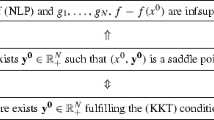Abstract
General and quasi-concave non-differentiable cases of the maximization of the minimun between two functions are considered. With the aid of duality theory for mathematical programming involving conjugate-like operators and by defining a bifunction we construct a new Lagrangian and generate a class of perturbations. New saddle-point theorems are presented, and equivalence is proved between the existence of a saddle-point and the existence of a certain cone-supporting property of the perturbation function. These results suggest possible improvements in multiplier methods.
Similar content being viewed by others
References
M.P. Crouzeix, “Conjugacy in quasi-convex analysis”,Convex analysis and its applications, Lecture Notes Vol. 144 (Springer, Berlin, 1976) 66–99.
J.P. Crouzeix, “Contributions à l'étude des fonctions quasi-convexes”, Thèse de Doctorat, Université de Clermont, France (1977).
J. Flachs and M.A. Pollatschek, “Further results in fuzzy mathematical programming”,Information and Control 38 (1978) 241–257.
J. Flachs and M.A. Pollatschek, “Duality theorems for certain programs involving minimum or maximum operators”,Mathematical Programming 16 (1979) 348–370.
J. Flachs and M.A. Pollatschek, “Equivalence between the generalized Fenchel duality theorem and the saddle-point theorem for fractional programming”,Journal of Optimization Theory and Applications, to appear.
A.M. Geoffrion, “Duality in nonlinear programming: a simplified applications-oriented development”,SIAM Review 13 (1971) 1–37.
H.J. Greenberg and W.P. Pierskalla, “Quasi-conjugate functions and surrogate duality”,Cahiers du Centre de l'Etude de Recherche Operationelle 15 (1973) 437–448.
D.G. Luenberger, “Quasi-convex programming”,SIAM Journal of Applied Mathematics 16 (1968) 1090–1095.
R.B. Myerson, “Two person bargaining problems and comparable utility”,Econometrica 45 (1977) 1631–1637.
O. Mangasarian,Nonlinear programming (McGraw-Hill, New York, 1969).
R.T. Rockafellar,Convex analysis (Princeton University Press, Princeton, 1970).
R.T. Rockafellar, “A dual approach to solving nonlinear programming by unconstrained optimization”,Mathematical Programming 5 (1973) 354–373.
R.T. Rockafellar, “The multiplier method of Hesteness and Powell applied to convex programming”,Journal of Optimization Theory and applications 12 (1973) 555–562.
R.T. Rockafellar, “Solving a nonlinear programming problem by way of a dual problem”,Symposia Mathematica (1976) 135–160.
S. Schaible, “Duality in fractional programming: a unified approach”,Operations Research 24 (1976) 452–461.
S. Schaible, “Fractional programming I, duality”,Management Science 22 (1976) 858–867.
J. Stoer and C. Witzgall,Optimization in finite dimensions I (Springer, Berlin, 1971).
Author information
Authors and Affiliations
Additional information
This work was partially supported by a grant from Control Data.
Rights and permissions
About this article
Cite this article
Flachs, J. Global saddle-point duality for quasi-concave programs. Mathematical Programming 20, 327–347 (1981). https://doi.org/10.1007/BF01589356
Received:
Revised:
Issue Date:
DOI: https://doi.org/10.1007/BF01589356



